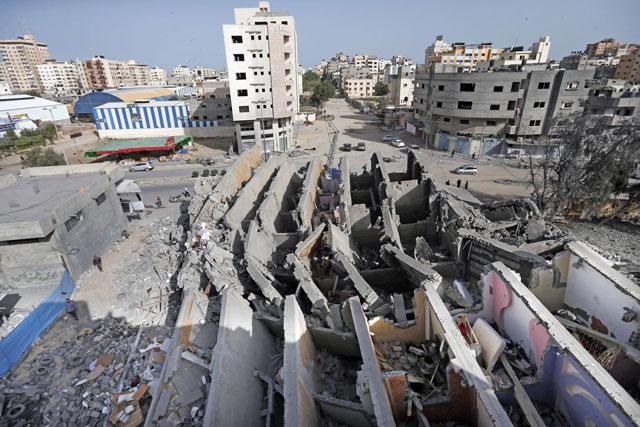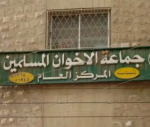You are here
A grim stalemate at war’s end in Gaza
By AP - Aug 28,2014 - Last updated at Aug 28,2014
TEL AVIV — The third Gaza War in six years appears to have ended in another sort of tie, with both Israel and Hamas claiming the upper hand. Their questionable achievements have come at a big price, especially to long-suffering Palestinians in Gaza.
In a sense, Israel got what it wanted: Hamas stopped firing rockets in exchange for mostly vague promises and future talks. But the cost to Israel was huge: Beyond the 70 people killed — all but six of them soldiers — the economy has been set back, the tourism season destroyed, its people rattled for 50 days and its global standing pummeled by images of devastation in Gaza.
Prime Minister Benjamin Netanyahu faces bristling from people who sense that Hamas controlled events and could not have its grip loosened on the Gaza Strip, which it seized by force from the Palestinian Authority in 2007. Around the corner lie international investigations into war crimes allegations.
Hamas is celebrating its success after surviving Israel’s far superior firepower. The Islamic group’s rocket fire emptied a string of Israeli border communities and disrupted Tel Aviv’s international airport. Weak a few months ago, it may emerge as more of a player in Palestinian politics, and the plight of Gazans is again atop the world’s concerns.
It also paid dearly: 2,143 Palestinians were killed, including nearly 500 children and hundreds of fighters. The UN estimates the war destroyed or severely damaged 17,200 homes and left 100,000 Palestinians homeless, with considerable swaths of Gaza in rubble. Hamas’ rocket arsenal is much depleted and many — if not all — of its attack tunnels against Israel have been destroyed.
For the moment, Israel has promised to open border crossings with Gaza to a degree, something it does intermittently anyway, and to increase access for Gaza fishermen. Hamas’ other demands are to be later discussed: an airport and seaport, prisoner releases, salaries for its thousands of civil servants and the opening of the Rafah crossing to Egypt. Israel will ask for demilitarising Gaza. Little is likely to be resolved anytime soon.
The region is unpredictable. But as it seems this ceasefire may stick, here are some preliminary lessons:
Force may have worked
For 50 days, Hamas stuck to its rockets. Israel started with carefully targeted destruction of sites, but steadily escalated its strikes. It razed neighbourhoods and killed top fighters. This week, Israel destroyed whole apartment towers. Hamas’ fight was at first genuinely supported by Gazans desperate for an end to the embargo of the strip by Israel and Egypt — a policy largely meant to squeeze out Hamas. But in the end, probably sensing the population couldn’t take more, Hamas accepted a deal that does not differ much from the first Egyptian cease-fire proposal offered in mid-July and accepted then by Israel. The moral side of Israel’s use of devastating force will be debated and its legality may end up being examined at The Hague, but the outcome suggests it achieved its aims. Netanyahu said as much Wednesday, telling a news conference that Hamas was surprised by the intensity of Israel’s attacks in the last week of the war. Especially interesting was the minimal protest in the Arab world, where Hamas suffers from association with the Islamist groups increasingly marginalised and feared around much of the region.
The palestinians showed more resilience
Gazans are hardly free to oppose Hamas’ rule, but it was still striking how much more pressure there was on Netanyahu to find a way to end the war. Also striking was the differing view of combatant deaths: At Hamas funerals in Gaza, the mood bordered on celebratory; in Israel, the soldiers’ deaths brought national bereavement. This limited Netanyahu’s options: Removing Hamas meant invading the heart of Gaza City and potentially losing many hundreds of troops in urban warfare. There was little stomach for this in Israel, however great the outrage over Hamas and its rockets. It would have been even worse for Netanyahu had the Iron Dome missile defence system not successfully protected Israelis from most of the missiles.
The palestinian unity goverment is back
Israelis say that since Hamas embeds itself in civilian areas, there was no choice but to target those areas while making efforts to diminish civilian casualties by issuing warnings. Yet there were alternatives. Israel could have accepted some of Hamas’ demands despite reservations about doing so under fire. In May, Israel could have cautiously accepted the establishment of a technocratic Palestinian “unity government” that was backed by both Hamas and the moderate Fateh group, which runs the Palestinian Authority and its autonomous enclaves in the West Bank. Palestinian President Mahmoud Abbas said that government backed continued peace efforts even though Hamas itself may not, yet Netanyahu launched a diplomatic campaign against Abbas for aligning himself with “terrorists”. What followed was the killing by Hamas activists of three Jewish teens in the West Bank, an Israeli crackdown on Hamas in the “territory”, and the start of the violence. Now Israel seems less upset about the unity government. It would probably be grateful to have the Palestinian Authority back in Gaza, running at least the borders, handling the reconstruction aid projects — and in general, keeping Hamas in check.
Prospects for real peace remain bleak
Whatever lies ahead, the bigger Israeli-Palestinian story remains the same: A majority on both sides wants peace and accepts partition of the holy land into two states — but when the other side’s terms are considered, they cannot do a deal. Israel has always feared a total West Bank pullout that would leave it about 15 kilometres wide at its narrowest point. Jihadist advances in the face of Arab governments’ haplessness now compound that fear. There is talk in the territories of asking the world to force Israel to accept the Palestinians’ terms — a follow-up to the UN General Assembly’s recognition in 2012 of a “state of Palestine” in all of Gaza, the West Bank and east Jerusalem. The Palestinians tend to describe such efforts, as well as the recent US-led negotiating effort that fizzled, as “last chances” to save the “two-state solution”. When that’s off the table, their vision does not lean towards accepting a future as an occupied people. More likely is another uprising, or a push by the Palestinians for a single state over all the territory of the holy land, in which Arabs and Jews would be equal citizens. Israel fears the first and ferociously opposes the second, because it would bury the Zionist dream of a national home for the Jews.
Related Articles
Israel resumed a punishing air campaign against Gaza Tuesday after its Islamist foe Hamas rejected a six-hour truce and fired dozens of rockets over the border, killing a first Israeli.
GAZA/OCCUPIED JERUSALEM — Rockets and missiles from Gaza killed four civilians in Israel while Israeli strikes killed 19 Palestinians, more
GAZA CITY, Palestinian Territories — Palestinian leaders in Gaza announced a ceasefire with Israel on Monday to end a deadly two-day escalat



















